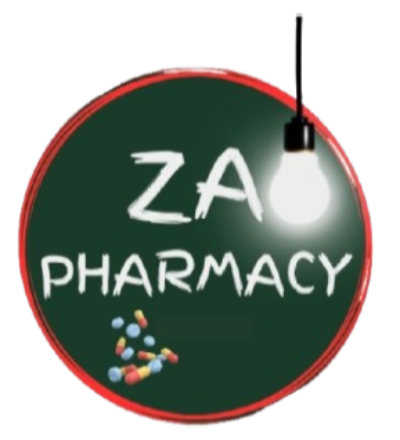Za Pharmacy
Drugs, Supplies and Delivery
Acetylcysteine
Acetylcysteine, also known as N-acetylcysteine (NAC), is a versatile medication with applications in respiratory health, liver protection, and as an antidote for acetaminophen (paracetamol) overdose. It is a derivative of the amino acid cysteine and works by replenishing glutathione, a critical antioxidant in the body. This article provides a detailed overview of acetylcysteine, referencing authoritative sources such as the British National Formulary (BNF), Lippincott Textbook of Pharmacology, and Lange Basic & Clinical Pharmacology. We will explore its mechanism of action, uses, dosage, side effects, precautions, drug interactions, and generic names in pharmacy.
Acetylcysteine exerts its effects through multiple mechanisms, depending on its clinical use:
- Mucolytic Action:
- Acetylcysteine breaks disulfide bonds in mucoproteins, reducing the viscosity of mucus in the respiratory tract.
- This makes it easier to clear secretions from the airways, improving breathing in conditions like chronic obstructive pulmonary disease (COPD) and cystic fibrosis.
- Antioxidant Action:
- Acetylcysteine is a precursor to glutathione, a potent antioxidant that neutralizes free radicals and reactive oxygen species (ROS).
- By replenishing glutathione levels, acetylcysteine protects cells from oxidative stress and damage.
- Antidote for Acetaminophen Overdose:
- In cases of acetaminophen (paracetamol) overdose, acetylcysteine prevents liver damage by binding to the toxic metabolite N-acetyl-p-benzoquinone imine (NAPQI) and replenishing glutathione stores.
- Renal Protection:
- Acetylcysteine may reduce the risk of contrast-induced nephropathy (kidney damage) in patients undergoing imaging studies with iodinated contrast agents.
Acetylcysteine is used for the following conditions:
- Respiratory Conditions:
- Chronic Obstructive Pulmonary Disease (COPD): Reduces mucus viscosity, improving airway clearance.
- Cystic Fibrosis: Helps manage thick, sticky mucus in the airways.
- Bronchiectasis: Aids in clearing excessive mucus.
- Acetaminophen Overdose:
- Prevents or reduces liver damage caused by toxic metabolites of acetaminophen.
- Contrast-Induced Nephropathy:
- Reduces the risk of kidney damage in patients receiving iodinated contrast media.
- Psychiatric and Neurological Disorders (Off-Label):
- Used as an adjunct in conditions like bipolar disorder, obsessive-compulsive disorder (OCD), and neurodegenerative diseases due to its antioxidant properties.
- Liver Protection:
May be used in other forms of drug-induced liver injury or non-acetaminophen-related liver failure.
The dosage of acetylcysteine varies depending on the condition being treated. Always follow the prescribing physician’s instructions.
Common Dosages:
- Acetaminophen Overdose:
- IV Route: 150 mg/kg in 200 mL of 5% dextrose over 15–60 minutes, followed by 50 mg/kg in 500 mL over 4 hours, then 100 mg/kg in 1000 mL over 16 hours.
- Oral Route: 140 mg/kg initially, followed by 70 mg/kg every 4 hours for 17 doses.
- Respiratory Conditions:
- Inhalation: 1–10 mL of 10% or 20% solution nebulized 3–4 times daily.
- Oral: 200–600 mg 2–3 times daily.
- Contrast-Induced Nephropathy:
- Oral: 600–1200 mg twice daily, starting the day before and continuing on the day of the procedure.
- IV: 600–1200 mg before and after the procedure.
Administration Tips:
- For inhalation, use a nebulizer and follow proper cleaning instructions to prevent contamination.
- For IV administration, ensure proper dilution to avoid adverse reactions.
Oral formulations should be taken with plenty of water to prevent gastrointestinal irritation.
Acetylcysteine is generally well-tolerated, but some patients may experience side effects:
Common Side Effects:
- Inhalation:
- Bronchospasm (especially in asthmatics)
- Stomatitis (mouth irritation)
- Rhinorrhea (runny nose)
- Oral/IV:
- Nausea and vomiting
- Diarrhea
- Skin rash or itching
Rare but Serious Side Effects:
- Anaphylaxis: Severe allergic reactions, particularly with IV administration.
- Bronchospasm: Severe airway constriction, especially in asthmatics.
- Hepatotoxicity: Rare cases of liver dysfunction.
If severe side effects occur, discontinue use and seek immediate medical attention.
Before using acetylcysteine, inform your healthcare provider if you have:
- Asthma or a history of bronchospasm
- Peptic ulcer disease (for oral formulations)
- Liver or kidney disease
- Allergies to acetylcysteine or any component of the formulation
Special Populations:
- Pregnancy: Generally considered safe when used for acetaminophen overdose or respiratory conditions. Consult a healthcare provider for other uses.
- Breastfeeding: Limited data; use only if clearly needed.
- Elderly Patients: Use with caution due to potential renal or hepatic impairment.
Acetylcysteine may interact with other medications, altering their effects:
- Activated Charcoal:
- Reduces the absorption of oral acetylcysteine when used for acetaminophen overdose. Administer acetylcysteine first, followed by charcoal if needed.
- Nitroglycerin:
- Concurrent use may cause severe hypotension and headaches.
- Anticoagulants:
- Acetylcysteine may enhance the effects of blood thinners like warfarin, increasing the risk of bleeding.
- Antihypertensives:
- May potentiate the blood pressure-lowering effects of antihypertensive drugs.
- Contrast Media:
Acetylcysteine is used to reduce the risk of contrast-induced nephropathy but may interact with other medications administered during imaging
- Acetylcysteine
- N-acetylcysteine (NAC)

